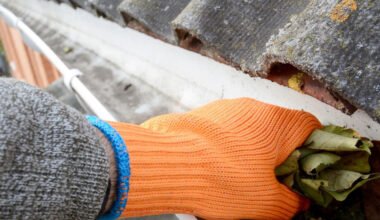A thorough cleaning of the facade and walkways is recommended at least once a year. If not regularly removed, various contaminants will slowly begin to degrade the materials. This includes soot, exhaust residue, mineral deposits, mold, moss, efflorescence on brick, rust from metal parts, and other similar contaminants. In this article, we’ll explore the tools and products that will help you clean quickly and effectively.
Wash It Yourself or Call Professionals?
Obviously, the easiest way is to hire power washing professionals who will quickly and efficiently clean both the facade and the walkways. However, many people want to save money or be able to proudly say, “I cleaned up all the dirt myself.” Before making a decision, it’s worth carefully weighing your options. Facade cleaning is a labor-intensive task that can be challenging for older individuals. Furthermore, back or joint problems can also be a hindrance. So if this is too difficult for you, don’t hesitate to call in the professionals.
Washer, Brush, or Hose?
There are many tools for mechanical and automatic facade cleaning. The choice depends on the type and degree of contamination.
- A stiff brush, wire brush, or putty knife is only suitable for removing light dirt on surfaces such as brick, stone, or wood.
- Soft brushes can be used to clean stains on more fragile materials, such as ceramic tiles, vinyl siding, or plaster surfaces.
- A hose is helpful for the initial and final rinsing of dust, dirt residue, and chemicals, as the water pressure is usually low.
- A high-pressure washer is the best option for removing multiple stains, such as soot, efflorescence, rain deposits, and exhaust residue.
It provides greater pressure than a standard hose and is suitable for virtually all surfaces thanks to its adjustable pressure, various attachments, and the ability to use multiple cleaning agents added to the water.
For example, if you need to remove dirt from a large area, a fan nozzle will be helpful, as it sprays liquid over a much larger area than a standard lance nozzle. A corner nozzle is ideal for cleaning hard-to-reach places, such as crevices or under roof overhangs. A foam nozzle, thanks to its dense foam head, is better at removing dried-on and stubborn dirt.
A versatile, and therefore most popular, power washer for homeowners is the Sterwins 135, with a maximum pump pressure of 135 bar. This device is suitable for cleaning not only facades and garden paths, but also cars, construction equipment, and garden furniture.
The more fragile the material you’re cleaning, the lower the pressure you should set the washer. It is also advisable to constantly move the sprayer when using it so that the water jet does not damage the surface being washed.
Which Cleaning Agent to Use
The simplest cleaning agent is clean water. It effectively removes road grime and fresh stains from the facade. However, if you need to remove stains that have been stuck to the facade for several months, such as paint stains, oil, and grease, it’s better to use chemicals. Water may not be adequate, and even if it is, you’ll need a lot of it, which will significantly increase the cleaning time.
Any touchless car wash product, such as Axton, will handle oil stains, soot, carbon, and atmospheric pollution—streaks from rain and melted snow. Paint remover will remove dried paint stains. For efflorescence, it’s best to use an efflorescence remover. Special mold removers combat moss, lichen, mold, and other organic matter.
These chemicals for facades, garden paths, and cars can be applied with a broad brush, roller, or added to a container of water, from which a mini-wash will draw the liquid. These products are available in concentrated and pre-diluted forms, so they must be added in different proportions. Read the instructions on the packaging carefully before use.
Facade Material
The first step in cleaning any surface is to remove external dust and dirt with clean water from a hose. In the second step, depending on the facade material, different cleaning products and tools are used.
Brick Surfaces
These surfaces often develop efflorescence, moss, lichen, and mold, leaving behind soot and grime stains. The facade should be cleaned with a scraper or brush and a universal touchless cleaner or mold remover. Rinse the surface with a hose and dry it thoroughly. Then, evenly go over the masonry with a high-pressure washer and an efflorescence remover.
Wood Surfaces
Wood, like brick, is more susceptible to organic contaminants. It is recommended to first clean difficult areas by hand with stiff-bristled brushes, then use a high-pressure washer with a touchless cleaner and/or a universal mold remover for various surfaces.
Stone, Tiles, Marble, Limestone
Surfaces finished with ceramic tiles (ceramics, clinker, porcelain tiles, natural stone) can be cleaned with brushes and a grinder, followed by a wash with acid-based cleaners using a high-pressure washer. For limestone, marble, and dolomite, alkaline-based cleaners are the best choice.
Siding Facades
Vinyl or acrylic siding and plaster are much more fragile materials than brick and stone. High pressure and harsh cleaning agents can easily deform them, so a gentler approach is required without the use of a pressure washer. Today, there are special cleaners for siding that do not contain harsh ingredients and are suitable for hand washing.
Conclusion
Cleaning your facade, garden paths, and other surfaces on your property is essential not only quickly but also safely. Some cleaning products are quite caustic and can irritate if they come into contact with your skin or eyes. When working with chemical cleaning products, it’s essential to protect your skin and mucous membranes. For this, you should wear at least protective goggles and gloves, and ideally, a disposable protective suit. You can purchase everything you need at a home improvement store. The easiest way is to hire a pressure washing company for excellent results without the unnecessary risks.



